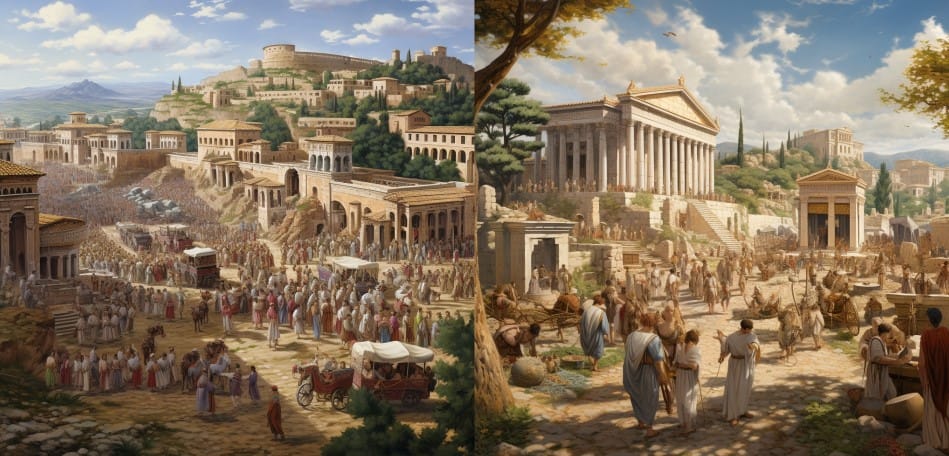Ancient Roman Rural Life: A Spiritual and Agricultural Tapestry

Key Takeaways:
- Ancient Roman countryside life was deeply intertwined with spirituality, with every natural element and activity under the watch of a deity.
- Agriculture, central to rural life, involved rituals to appease gods for a bountiful harvest.
- Key festivals included Liberalia for Liber, Fordicia for Tellus, and Ceres’ festival for agriculture, all involving specific rituals and sacrifices.
- The calendar was marked with festivals celebrating various deities, each with unique customs, reflecting the Romans’ close connection to nature and the divine.
Introduction:
Exploring the rich tapestry of ancient Roman rural life reveals a deep spiritual connection to nature, marked by festivals and rituals dedicated to various gods.
The Divine in Every Aspect of Nature:
Ancient Romans saw the natural world as a realm filled with spirits and deities, each playing a role in everyday life. This belief system manifested in numerous festivals and rituals throughout the year, starting with the Liberalia on March 17th to honor Liber, the god of crops and vineyards. April was a particularly busy month, featuring the Fordicia, a sacrifice to the earth goddess Tellus, and a festival for Ceres, the goddess of agriculture and grain. These rituals, often involving sacrifices and purification, were vital for ensuring a prosperous harvest and protecting the land.
Seasonal Festivals and Rituals:
The cycle of festivals and rituals was closely tied to the agricultural calendar, reflecting the Romans’ dependence on and reverence for nature’s cycles. From the Vinalia Rustica, a wine feast marking the end of winter, to the Saturnalia in December, a precursor to modern Christmas celebrations, each event had its own unique customs and significance.
Summer to Winter: A Continuation of Celebrations:
After the April festivals, the Vinalia Rustica in late summer celebrated the end of winter, likely accompanied by liberal consumption of wine. The peculiar ritual of sacrificing a red dog to Robigus, the god of mildew, took place in April too, underlining the Romans’ deep concern for protecting their crops from natural calamities.
The Floralia, from April 28 to May 3, was a grand celebration of blossoms, indicative of the Romans’ appreciation for nature’s beauty and bounty. As the year progressed and crops ripened, the Ambarvalia took place, a festival without a fixed date, featuring another lustration march around the land to ensure the crops’ success and the gods’ favor.
In August, the harvest brought festivals for Ops, the goddess of harvest, and Consus, the granary god, celebrating the yield’s gathering. Another Vinalia Rustica also occurred, further emphasizing the importance of wine in Roman culture.
End of Year Festivities:
The Meditrinalia on October 11 celebrated the wine crop, showcasing the cyclical nature of agricultural and spiritual life in ancient Rome. December was a time for sowing, marked by more festivals in honor of Ops and Consus, culminating in the Saturnalia beginning on December 17. Originally a festival to honor Saturn, the god of agriculture, it evolved into a time of general merriment and feasting, a precursor to the Christmas celebrations in the Christian era.
Conclusion:
Roman rural life was a vivid tapestry of festivals and rituals, each deeply rooted in agricultural practices and the reverence for nature and the divine. These celebrations were not just mere traditions but a reflection of the Romans’ profound connection with the natural world, which governed their lives and shaped their cultural ethos. The cycle of festivals, closely tied to the agricultural calendar, highlights the interplay between spiritual beliefs and everyday life in ancient Rome, offering a window into the civilization’s rich heritage and its enduring influence on Western culture.

Historian Franco Cavazzi dedicated hundreds of hours of his life to creating this website, roman-empire.net as a trove of educational material on this fascinating period of history. His work has been cited in a number of textbooks on the Roman Empire and mentioned on numerous publications such as the New York Times, PBS, The Guardian, and many more.
